“The women who died for Ireland” – Cumann na mBan fatalities in the War of Independence & Civil War –
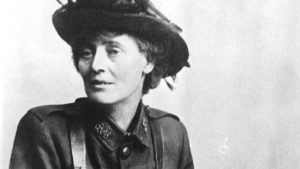
By Pádraig Óg Ó Ruairc
Twenty Nineteen marks the centenary of the appointment of Constance Markievicz as Minister for Labour in Dáil Éireann.
This was a remarkable event in Irish history, not only because there wasn’t another female minister appointed to an Irish Government until Maire Geoghan–Quinn in 1977, but also because Markievicz was the first female cabinet minister in Europe. The recent celebrations of Marckievicz’s political rise has placed a renewed focus on the role of women in the Irish Revolution of 1913 -1923.
Focus on women’s involvement in the Irish revolution has generally centred on elite women such as Constance Markievicz.
Over the last few months, several other important milestones in the history of women’s struggle in Ireland have just passed with significant fanfare – most notably the centenaries of the extension of the vote to women and the election of Markievicz as the first female M.P. So far there has been a lot of fuss about this in media and political circles and in the coming months we can expect to see more hype about celebrating a hundred years of the active involvement of women in politics.
Of course any advances in the cause of equal political representation between men and women is something that deserves celebration – but spare a thought for the handful of Cumann na mBan women who died for that same cause, but who are now largely forgotten.
Cumann na mBan: a military force?
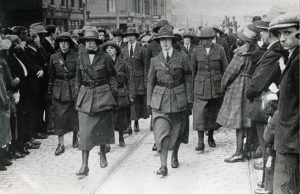
Following the enrollment of women in the Irish Citizen Army in 1913 and the formation of Cumann na mBan in 1914, female republicans were eager to carry arms and take the same risks as their male comrades. However, during the 1916 Rising republican women were usually confined to cooking, first aid, messaging and signalling duties in support of male combatants.
Although some women, such as Constance Marcievicz and Margaret Skinnider, claimed a full role as combatants, they were the exception and no female combatants were killed during the 1916 Rising. Despite numerous claims to the contrary Nurse Margaretta Keogh who was killed by the British Army during the fighting at South Dublin Union though frequently cited as a republican casualty, was a civilian nurse and not an active member of the republican garrison nor a member of Cumann na mBan.
Women undertook dangerous work transporting arms and explosives during the War of Independence but the only occasion that women were permitted by their male comrades to play a direct role in attacking the enemy appears to have happened during the IRA attack on Kilmallock RIC Barracks when one IRA Volunteer recalled “The Cumann na mBan women … used a rifle and boiled kettles as required.”[1]
Although forbidden from fighting on the battlefield, republican women were still at risk of serious injury from their encounters with the British Forces and at least two Cumann na mBan women – Josie McGowan and Margaret Keogh were killed during that conflict.
Josephine McGowan

McGowan was the first of several Cumann na mBan women who died during the struggle to establish an Independent Irish Republic. Markievicz struggled for freedom – McGowan died for it, yet Markievicz is widely remembered and McGowan is almost totally forgotten and the centenary of her death passed without any of the pomp and ceremony we saw marking the 100th anniversary of Markievicz’ election.
“Josie” McGowan was from Dolphin’s Barn, Dublin and had served as a member of the Marrowbone Lane Garrison during the 1916 Rising.
On the 22nd September 1918 McGowan attended a Cumann na mBan rally at Foster Place to protest against the internment of republican prisoners jailed as part od the so-called “German Plot”. The Dublin Metropolitan Police baton charged the assembly and during their onslaught a DMP Constable struck McGowan several times on the head with his baton.
McGowan’s comrades rescued her from the assault and took her to their medical outpost in Ticknock. She died there on the 29th September 1918 and was buried in Glasnevin Cemetery. Her father suffered a huge emotional trauma at his loss and died a week later aged just 46 years. They are both buried in the same grave plot in Glasnevin. Over two decades later McGowan was posthumously awarded a War of Independence service medal, which included a ‘Comhrac’ bar – an award normally reserved for male combatants.[2]
Cumann na mBan deaths in the War of Independence and Truce
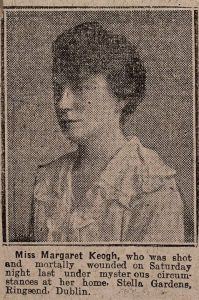 The second member of Cumann na mBan killed was Margaret Keogh a nineteen year old printer’s assistant. Keogh was fatally wounded by a gun shot in her home at Stella Gardens, Ringsend, Dublin at 11.15 pm on the 10th July 1921 during a series of raids by the British Crown forces on the eve of the truce which ended the War of Independence.
The second member of Cumann na mBan killed was Margaret Keogh a nineteen year old printer’s assistant. Keogh was fatally wounded by a gun shot in her home at Stella Gardens, Ringsend, Dublin at 11.15 pm on the 10th July 1921 during a series of raids by the British Crown forces on the eve of the truce which ended the War of Independence.
She died of her wounds the day after the ceasefire began. If there was one woman who embodied all of the various strands entwined in the Irish Revolution it was Margaret Keogh.
Three women republicans were killed between 1918 and 1921.
Keogh was the Captain of the Croke Ladies Hurling Club, a member of the Irish Clerical Workers Union and was an active member of Cuman na mBan. A year prior to her death, Keogh had been arrested by the British forces for refusing to give her name in English when questioned about her fundraising activities for Conradh na Gaeilge which was then a proscribed organisation.
Her funeral took place at Glasnevin Cemetary, on the 14th July 1921 and she was buried with military honours by her comrades in Cumann na mBan. Today her grave is marked by a humble headstone bearing the inscription ‘MARGARET KEOGH – DIED FOR IRELAND’.[3]
During the Truce period a further three members of Cumann na mBan were killed. Margaret McAnaney was accidentally shot dead by an IRA Volunteer whilst delivering dispatches at Burnfort, Donegal on the 31st May 1922. The same day Margaret McElduff died of an accidental gunshot wound whilst transporting a gun for the IRA in County Tyrone. Another member of Cumann na mBan Nóra O’Leary died in similar circumstances the same year when she was accidentally shot dead in her home when IRA Commandant Denis Reen accidentally discharged his rifle.[4]
The Civil War

Either because of political idealism, or more likely – military necessity, women were allowed to play a fuller military role during the Civil War.
For example; Elizabeth Maguire acted as a quartermaster for the IRA’s Dublin Brigade and was involved in twenty eight attacks on Free State troops. Sighle Humphries led an armed Cumann na mBan unit in a raid on a hospital in October 1922 in an attempt to free a wounded IRA Volunteer guarded by Free State soldiers.[5] The following month she was involved in a gun battle with Free State Army when they captured Ernie O’Malley the IRA’s Assistant Chief of Staff. It is unsurprising therefore that Cumann na mBan fatalities doubled during the Civil War.[6]
Anti-Treaty Republican women played a more active military part in the Civil War and four were killed.
The first member of Cumann na mBan killed in that conflict was Mary Hartney from Limerick city. On the 4th August 1922, the Free State Army used artillery to drive the IRA from the town of Adare, County Limerick. The Dunraven Arms Hotel, where the republicans had set up their military headquarters, suffered a direct hit during the opening barrage.
A short time later a correspondent from the Free State Army’s Publicity Department reported that ‘… all the rooms in the building were found to be bespattered with blood, showing that there must have been fairly severe casualties amongst the irregulars’. In fact only one member of the garrison had been killed – Mary Hartney. She had been working as part of a First Aid unit was killed instantly in an explosion caused by the shellfire. Hartney was buried in the Republican Plot of Mount St. Lawrence Cemetery, Limerick on 7th August 1922.[7]
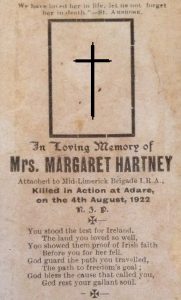 The next member of the Cumann na mBan killed by the Free State army was Lily Bennett from Aughrim Street, Dublin. The Republican Prisoners Defence Committee held a public rally each Sunday in O’Connell Street. On 18th November 1922 Lily Bennett was attending the demonstration when Free State troops passing by in a motor convoy attacked the protesters.[8]
The next member of the Cumann na mBan killed by the Free State army was Lily Bennett from Aughrim Street, Dublin. The Republican Prisoners Defence Committee held a public rally each Sunday in O’Connell Street. On 18th November 1922 Lily Bennett was attending the demonstration when Free State troops passing by in a motor convoy attacked the protesters.[8]
An eyewitness told the Irish Times “The meeting had only lasted about five minutes when a lorry of National troops attended by an armoured car , came along from the direction of Parnell Square and halted beside the gathering. … An officer ordered the meeting to disperse … revolver shots rang out … evidently fired by supporters of the meeting. The huge crowd began to break up amid great confusion … a machine gun was trained on the crowd, and an unnerving rattle of fire was next heard and people trampled on one another in their flight.”
Charlotte Despard who had been addressing the meeting later insisted that the Free State Army had opened fire without provocation. Seven people were seriously wounded in the attack including Lily Bennet who had been shot in the back and died a short time later.[9]
Another member Cumann na mBan, Margaret Dunne from Cappaleigh South near Castletown in West Cork, was shot dead by the Free State Army six months later. On the 8th April 1923 a Free State soldier was wounded during a gunfight with two IRA Volunteers at Adrigole. Approximately ten minutes later the Free State troops spotted Dunne conversing with a third IRA Volunteer who had not been involved in the attack.
In an apparent act of reprisal for the wounding of his comrade, Captain Hassett of the Free State Army drew a gun and opened fire on the pair, shooting Margaret Dunne dead. Throughout the Civil War Cumann na mBan had rendered military honours at the funerals of IRA Volunteers killed in action – but for Dunne’s funeral the situation was reversed as the men of the IRA came out of hiding and risked capture and execution to pay tribute to their fallen female comrade.[10]
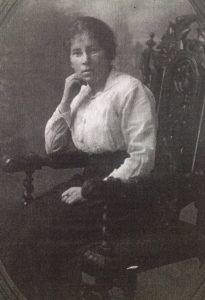
The final member of Cumann na mBan to die as a result of the conflict appears to have been Annie ‘Nan’ Hogan from Cratloe in County Clare. Hogan had organised safe houses during the War of Independence and was leader of the East Clare Brigade of Cumann na mBan.
Late in 1922 the republican prisoners in Limerick prison had organised an escape attempt by digging a tunnel. However the plot was betrayed and on the night of the escape attempt Free State soldiers arrested seven Cumann na mBan women outside the prison including Annie Hogan. Hogan was interned without trial in Kilmainham Gaol and went on hunger strike in March 1923 for better conditions and prisoner of war status.
Eventually the hunger strike was called off when it became obvious that the Free State authorities would not concede their demands. Unfortunately, this development was too late to save Annie Hogan. She was released in September 1923 and died a short time later. Her family and friends attributed the twenty four year old’s premature death to her hunger strike and the conditions she had suffered in prison.[11]
Written out of History?
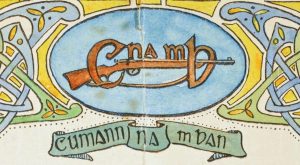 The idea is often put forward that women were deliberately “written out of history” and there was a recurring suggestion during the 2016 Centenary celebrations that the role of women in the republican struggle was somehow a “hidden history” which was only coming to light for the first time a century later.
The idea is often put forward that women were deliberately “written out of history” and there was a recurring suggestion during the 2016 Centenary celebrations that the role of women in the republican struggle was somehow a “hidden history” which was only coming to light for the first time a century later.
But there is little foundation to these suggestions – at least forty books have been written specifically about the role played by women during the Irish Revolution and many of these books were published well in advance of the 2016 Centenary of the Easter Rising.
Numerous female veterans of the struggle including Kathleen Clarke, Madame Czira, Margaret Skinnider, Nora Connolly-O’Brien, Maud Mitchell, Kathleen Keyes McDonnell, Maud Gonne, Lil Conlon, Brigid Dirranne and other female activists had their own biographies published during their lifetimes.
The idea is often put forward that women were deliberately “written out of history” but many books dealing with Cumman na mBan have been published since the 1960s
Furthermore history books focusing specifically on republican women have been continually published since the 1960s and female historians such as Dorothy McArdle, Ruth Taillion and most notably Margaret Ward brought the role of women in the conflict to public attention in popular history books decades before the 2016 centenary. So the role of women in the Irish Revolution was never “hidden”, “lost” or deliberately “covered up” through the machinations of some unnamed conspiracy.
What is certain though is that the deeds of the women who fought for Irish freedom were frequently overshadowed by the martial feats of their male counterparts. Women in the revolution (with a few notable exceptions mentioned above) were confined by their male comrades to a very strictly defined gendered and traditional role i.e. – signalling, delivering despatches, first aid work, cooking and cleaning. Some women succeeded in breaking this mould to provide vital support to the IRA’s campaign including intelligence work and the transporting of arms and explosives.
Inevitably when the romantic ideal of armed struggle by the “good old-IRA” came to be portrayed in stage dramas, television programmes and popular history books of the 1950’s and 1960’s the emphasis was always going to be on the young men who took up rifle and revolver to go into battle with the British foe.
What is true that the importance of women’s role in the military struggle was often glossed over in preference to a celebration of the masculine military qualities of IRA combatants.
When tokenism demanded that women be mentioned the easiest thing was to focus almost exclusively on Constance Markievicz about whom numerous books and articles had already been written and to ignore the ordinary women who served under her in the rank and file of Cumann na mBan.
What is surprising though is that in the numerous histories of Cumann na mBan there is very little mentioned of the women who died for the struggle and who are the focus of this article. Apart from notable exceptions such as Sinead McCoole’s “No Ordinary Women” which mentions the deaths of Hogan and Dunne, and Mary McAuliffe & Liz Gillis’s “We Were There – 77 Women of the Easter Rising” which details the death of McGowan, almost all histories of Cumann na mBan ignore the sacrifice of these women.
For example Ann Matthew’s 2012 book “Dissidents” which charted the history of Republican women in the Civil War period stated emphatically but mistakenly that “no Republican women died as a result of the conflict”.
Most recently the 2014 book “Cumann na mBan – 100 years defending the Republic” by Líta Ní Chathmhaoil failed to mention any of the women who had died in defence of the Republic in the years 1918 – 1923. Instead Ní Chathmhaoil’s book focuses on the members of Cumann na mBan or female Provisional-IRA Volunteers killed during the more recent conflict in the North of Ireland.[12]
The most likely reason why the stories of the republican women killed during the Irish Revolution have not been more widely recorded is that the majority of the Cumann na mBan women killed died during the Truce Period and Civil War which have often been neglected by scholars in favour of the War of Independence, furthermore throughout the period it is often to distinguish Cumann na mBan fatalities from female civilians killed in the conflict.
Today the men of the Irish Republican Army who fell in the struggle for Irish freedom are honoured by hundreds of monuments throughout Ireland. The boys of Na Fianna Éireann are commemorated by a monument dedicated to them in Stephen’s Green. – But what of the women?
There are currently four statues of Constance Markievicz (one in County Sligo and three others in the capital) with Dublin City Council reportedly planning a fifth statue of her. There is also an information plaque in Wynn’s Hotel Dublin marking it as the place where the inaugural meeting of Cumann na mBan was held. But as we pass the centenaries of the death of Josephine McGowan and her comrades in Cumann na mBan who died for Irish freedom, the question now arises why no national memorial has ever been erected commemorating all of the women of Cumann na mBan and the girls of the Clan na nGaedheal Girl Scouts who sacrificed so much for the same cause? Hopefully something will be done to rectify this national oversight before the centenaries of the death of Margeret Keogh in 2021 and Annie Hogan in 2023.
Dr. Pádraig Óg Ó Ruairc is the author of several books on modern Irish history and is a contributor to the Atlas of the Irish Revolution. – Many thanks to Dr. Andrew Bielenberg, Sam McGrath, John Dorney and Micheál Ó Doibhlin for their assistance with this article.
References
[1] James Maloney, Bureau of Military History, Witness Statement.
[2] Irish Military Archives, Cathal Brugha Barracks, Dublin. Medal Application for 1917 -21 Service Medal No. MD10018 for Josephine McGowan
[3] Ó Ruairc, Pádraig Óg, Truce – Murder, Myth and the last days of the Irish War of Independence, (Cork, 2016), pp. 240-9.
[4] Irish Military Archives, Cathal Brugha Barracks Dublin. Military Service Pension Applications No. DP6606 for Margaret MacAnaney, DP5886 for Annie McElduff and SP. G10 for Nóra O’Leary.
[5] Dorney, John, The Civil War in Dublin – The Fight for The Irish Capital 1922 to 1924, (Dublin 2017) p.162
[6] O’Malley, Ernie, The Singing Flame (Cork, 2016)
[7] O’ Callaghan, John, The Battle For Kilmallock (Cork, 2011)
[8] Dorney, John, The Civil War in Dublin – The Fight for The Irish Capital 1922 to 1924, (Dublin 2017) p163
[9] Irish Times, 19th November 1922
[10] Keane, Barry, Cork’s Revolutionary Dead 1916 -1923, (Cork, 2016)
[11] McCoole, Sinead, No Ordinary Women – Irish Female Activists during Ireland’s Revolutionary Years 1900 -1923, (Dublin, 2003)
[12] At least thirteen such women were killed in the Northern conflict, namely; Maura Meehan, Dorothy Maguire, Julie Dougan, Maura Drumm, Anne Parker, Vivien Fitzsimons, Pauline Kane, Anne Marie Pettigrew, Ethel Lynch, Laura Crawford, Rosemary Blakely, Margaret McArdle, Mairead Farrell. Some of these women were shot by the British Army or assassinated by Loyalist paramilitaries, but the majority were killed by premature explosions whilst on bombing missions. For more details see:- “Lost Lives – The Stories of the Men, Women and Children who died as a result of the Northern Ireland Troubles.”